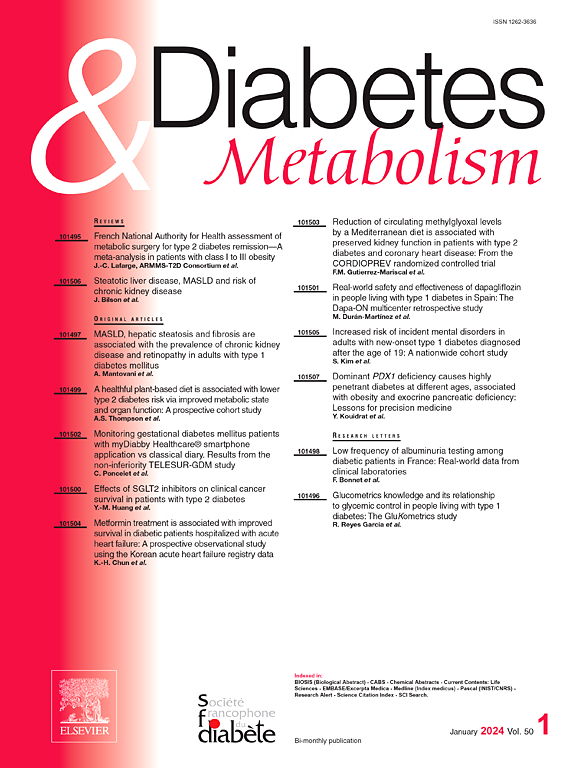Comparative study of SGLT2 inhibitors and metformin: Evaluating first-line therapies for dementia prevention in type 2 diabetes
IF 4.7
2区 医学
Q1 ENDOCRINOLOGY & METABOLISM
引用次数: 0
Abstract
Background
- Type 2 diabetes (T2D) increases the risk of dementia by 1.5 to 2.5 times. Sodium-glucose cotransporter 2 inhibitors (SGLT2is) and metformin, widely used antidiabetic therapies, have demonstrated potential neuroprotective effects. Their comparative effectiveness in dementia prevention remains unknown.
Methods
- This retrospective cohort study used the TriNetX global federated network, analyzing de-identified records from over 98 healthcare organizations. Adults with T2D initiating SGLT2i or metformin as first-line therapy were propensity score-matched (1:1). The primary outcome was overall dementia incidence, including vascular dementia, Alzheimer’s disease, and other subtypes. Secondary outcomes included all-cause mortality. Time-to-event outcomes were assessed using Kaplan-Meier curves and Cox models.
Results
- Among 74,975 matched patients in each cohort, SGLT2i use was associated with a lower incidence of overall dementia: 2.7 % vs. 6.9 %: adjusted hazard ratio (aHR) 0.80 [95 % CI 0.76;0.84]. Reductions were observed in vascular dementia (0.8 % vs. 2.0 %; aHR 0.87), Alzheimer’s dementia (1.1 % vs. 3.2 %; aHR, 0.76), and all-cause mortality (6.8 % vs. 15.4 %; aHR, 0.92). Benefits were pronounced in older adults, particularly those aged ≥80 years.
Conclusions
- SGLT2is significantly reduced dementia risk and mortality compared to metformin in T2D patients. These findings suggest SGLT2is may offer superior neuroprotective benefits, underscoring their potential as a first-line therapy for T2D. Further randomized trials are needed to confirm these results.
SGLT2抑制剂和二甲双胍的比较研究:评价预防2型糖尿病痴呆的一线疗法
背景- 2型糖尿病(T2D)使痴呆的风险增加1.5至2.5倍。钠-葡萄糖共转运蛋白2抑制剂(SGLT2is)和二甲双胍,广泛应用于降糖治疗,已显示出潜在的神经保护作用。它们在预防痴呆症方面的相对有效性尚不清楚。方法:这项回顾性队列研究使用TriNetX全球联合网络,分析了来自98个医疗保健组织的去识别记录。成人t2dm患者采用SGLT2i或二甲双胍作为一线治疗,倾向评分匹配(1:1)。主要结局是总体痴呆发病率,包括血管性痴呆、阿尔茨海默病和其他亚型。次要结局包括全因死亡率。使用Kaplan-Meier曲线和Cox模型评估事件发生时间。结果:在每个队列的74,975名匹配的患者中,SGLT2i的使用与较低的总体痴呆发病率相关:2.7% vs. 6.9%:校正风险比(aHR) 0.80 [95% CI 0.76;0.84]。血管性痴呆减少(0.8% vs. 2.0%;aHR 0.87),阿尔茨海默氏痴呆(1.1%对3.2%;aHR, 0.76)和全因死亡率(6.8% vs. 15.4%;aHR, 0.92)。在老年人中获益明显,尤其是年龄≥80岁的老年人。结论:与二甲双胍相比,sglt2dm可显著降低T2D患者的痴呆风险和死亡率。这些发现表明SGLT2is可能具有更好的神经保护作用,强调了它们作为T2D一线治疗的潜力。需要进一步的随机试验来证实这些结果。
本文章由计算机程序翻译,如有差异,请以英文原文为准。
求助全文
约1分钟内获得全文
求助全文
来源期刊

Diabetes & metabolism
医学-内分泌学与代谢
CiteScore
12.00
自引率
4.20%
发文量
86
审稿时长
13 days
期刊介绍:
A high quality scientific journal with an international readership
Official publication of the SFD, Diabetes & Metabolism, publishes high-quality papers by leading teams, forming a close link between hospital and research units. Diabetes & Metabolism is published in English language and is indexed in all major databases with its impact factor constantly progressing.
Diabetes & Metabolism contains original articles, short reports and comprehensive reviews.
 求助内容:
求助内容: 应助结果提醒方式:
应助结果提醒方式:


